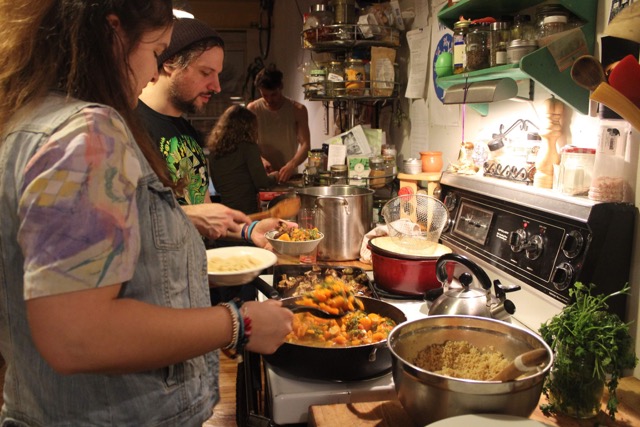Article by Catherine Hansen and Gabriela Simone
CSU workshop shares tips and resources for dumpster diving
The Concordia Student Union organized a free dumpster diving workshop on March 12 as part of their weekly DIY series. The two-part event kicked off with a dumpster diving theory class, which encompasses proper etiquette, health risks, legal aspects and a reflection on the eating habits of today’s society. The second half of the event had participants dumpster diving for food and making a meal with their findings.
The event was hosted by Isabella Leone and Coco Graziani of Les Échelles, a collective living space in Montreal’s Plateau neighbourhood that organizes free cultural events and encourages the sharing of food and resources. The majority of the food found in their fridge is gathered from dumpster diving. Residents of Les Échelles rarely spend money on food because they often find perfectly good produce that has been thrown away.
Graziani was raised in Italy and has been living in Montreal for four years. She spent the last two years living at Les Échelles and has taken up dumpster diving.
“Having dumpster diving as an option makes me feel less horrible when I eat food,” Graziani said. Dumpster diving allows her to “avoid going to grocery stores and buying things whose production rests on the exploitation of other humans and animals, and contributes to the further degradation of the environment.”
Leone and Graziani said dumpster diving is a viable option for people who want to save money on food and prevent food from being wasted, but it’s often trickier than it seems. While large quantities of edible food can be found in dumpsters, many building owners do not appreciate people rummaging through their garbage without permission.
To have a successful dumpster diving experience, Leone and Graziani said there is some important preparation involved, such as finding dumpsters ahead of time and making sure they are in a public space. Usually, if they are located in parking lots or behind buildings, they are considered private property. Other dumpsters, like those in alleyways, are considered public and can be looked through by anyone.
According to Graziani, proper diving etiquette includes not taking all the produce when large quantities are available and leaving the extras in a box outside of the dumpster.
The main health tip highlighted in the workshop was to make sure to soak produce in a bowl with water and a tablespoon of vinegar to disinfect it. As for moldy produce, Graziani and her friends have a rhyme they use to identify potentially dangerous mold: “Pink and black, put it back; blue and white, you’re alright.”
There are multiple resources dumpster divers can use to find the perfect diving spots, such as food drop-off and pick-up locations, the Health Canada recall website and a dumpster diving map available online. The map shows where dumpsters are located throughout the city, and are marked in either green or red. Pierre-Olivier Jourdenais, a workshop participant, wrote on the Dumpster Diving Workshop Facebook event page: ‘’The red dumpsters tend to be rarely fruitful, according to map markers, while the green ones are more likely to have things to dumpster dive. So, you’re avantaged to go for the green ones whenever possible, for efficiency reasons.’’
Jourdenais is a frequent dumpster diver who follows diving-related pages on Facebook, such as Free Food for Free People, a group created to inform people of drop-off points around Montreal where divers can collect food that would otherwise go to waste. “I often go to the drop-offs in Rosemont,” Jourdenais said.
One of the participants, Marina Kuneva, travelled all the way from Sherbrooke to attend the dumpster diving workshop with her friend, Valerie-Anne Codina-Fauteux, a student at the Université de Montréal. Codina-Fauteux said she likes how dumpster divers “don’t consider the standard way of consuming food as the only good way.”
Photo by Gabriela Simone
